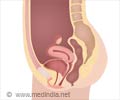After seven years of follow-up, results suggest that women considering abdominal sacrocolpopexy (surgery for pelvic organ prolapse [POP]) should be counseled that this procedure effectively provides relief from POP symptoms.

"Pelvic organ prolapse occurs when the uterus or vaginal walls bulge into or beyond the vaginal introitus [vaginal opening]. It is a common occurrence and 7 percent to 19 percent of women receive surgical repair," according to background information in the article. More than 225,000 surgeries are performed annually in the United States for POP. Abdominal sacrocolpopexy is the most durable operation for advanced POP and serves as the criterion standard against which other operations are compared, but little is known about safety and long-term effectiveness.
Ingrid Nygaard, M.D., of the University of Utah School of Medicine, Salt Lake City, and colleagues conducted a study to describe anatomic and symptomatic outcomes up to 7 years after abdominal sacrocolpopexy and to determine whether these are affected by anti-incontinence surgery (Burch urethropexy). The study consisted of a long-term follow-up of the randomized, 2-year Colpopexy and Urinary Reduction Efforts (CARE) trial of women with stress continence who underwent abdominal sacrocolpopexy between 2002 and 2005 for symptomatic POP and also received either concomitant Burch urethropexy or no urethropexy. Ninety-two percent (215/233) of eligible 2-year CARE trial completers were enrolled in the extended CARE study; and 181 (84 percent) and 126 (59 percent) completed 5 and 7 years of follow-up, respectively. The median (midpoint) follow-up was 7 years.
Of 215 women enrolled in the extended CARE study, 104 had undergone abdominal sacrocolpopexy plus Burch urethropexy and 111 had undergone abdominal sacrocolpopexy alone. The researchers found that that POP and urinary incontinence (UI) treatment failure rates gradually increased during the follow-up period. By year 7, the estimated probabilities of POP treatment failure for the urethropexy group and the no urethropexy group, respectively, were 0.27 and 0.22 for anatomic failure; 0.29 and 0.24 for symptomatic failure; and 0.48 and 0.34 for a composite of both.
Overall for the duration of the study, the estimated probability of stress urinary incontinence (SUI) was 0.62 for the urethropexy and 0.77 for the no urethropexy group. The expected time to treatment failure for the SUI outcome in the urethropexy group vs. the no urethropexy group was 131.3 months vs. 40.2 months, respectively.
The probability of mesh erosion at 7 years was 10.5 percent.
"We anticipate that continued research in mesh development will lead to new materials and applications with fewer adverse events, but our data highlight the importance of careful long-term evaluation of new devices. Comparative effectiveness trials with long-term follow-up of at least 5 years are needed to compare abdominal sacrocolpopexy that we described in this report with vaginal prolapse procedures that include and do not include mesh augmentation."
Editor's Note: This research was supported by grants from the Eunice Kennedy Shriver National Institute of Child Health and Human Development, and the Office of Research on Women's Health at the National Institutes of Health. Please see the article for additional information, including other authors, author contributions and affiliations, financial disclosures, etc.
Please Note: An author podcast on this study will be available post-embargo on the JAMA website.
Editorial: Pelvic Organ Prolapse Surgery - Long-term Outcomes and Implications for Shared Decision Making
"This study has important clinical implications and calls into question the designation of the abdominal sacrocolpopexy as the criterion standard procedure for prolapse repair," writes Cheryl B. Iglesia, M.D., of the Georgetown University School of Medicine, Washington, D.C., in an accompanying editorial.
"In this era of shared decision making, the next logical question is, 'How do physicians advise patients who are contemplating pelvic reconstructive surgery for prolapse?' Rates of prolapse and incontinence surgery are expected to increase substantially during the next 40 years as the population ages. Patients need to discuss with their physicians the available surgical and nonsurgical options for prolapse and incontinence, medical comorbidities, and review of available data. Surgeons and patients should also discuss prophylactic concomitant or staged surgery for stress incontinence at the time of prolapse repair. Timing of prolapse repair based on quality-of-life decisions should also be discussed preoperatively."(JAMA. 2013;309(19):2045-2046
Source-Eurekalert
 MEDINDIA
MEDINDIA




 Email
Email








